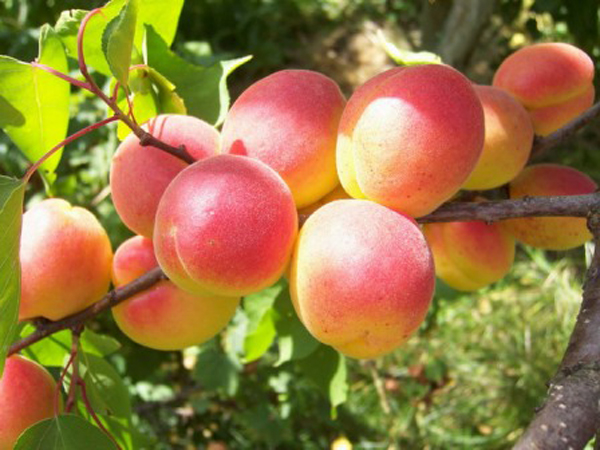Apricot Red-cheeked - description with photo
Among the huge number of varieties, the red-cheeked apricot stands out for its unpretentiousness, for which it is appreciated by many gardeners and this variety can be found in most summer cottages. The article gives a detailed description of this variety, and also describes its hybrid - apricot, the son of a red-cheeked, which has recently begun to gain popularity.
Content
Characteristics of the Krasnoschekiy variety
This apricot was bred by the Crimean breeders of the Nikitsky Botanical Garden a long time ago, in 1947. During this time, with its help, a large number of new hybrids were bred, including the son of Krasnoshchekiy, Krasnoshekiy late, Krasnoshekiy Nikolayevskiy, Krasnoshekiy Nikitskiy, Krasnoshekiy Salgirskiy and others. Hybrids can differ significantly in many characteristics from the “parent”.
The variety grows mainly in the southern regions. The tree is large with a spreading sparse crown and long branches. Life expectancy up to 50 years. Productivity is one of the highest among European varieties - up to 90 kg per tree.
When pruning, it should be remembered that the apricot bears fruit on last year's annual growths and bouquet branches.
Fruit
Apricot Red-cheeked ripens in the second decade of July. It should be borne in mind that ripening is uneven in time and can be delayed for a rather long period of time, this is especially true with good yields. Therefore, it is recommended to collect the fruits in several stages. Having reached full ripeness, apricots can easily crumble. Once harvested, the fruits can be stored and transported for up to 10 days.
The fruits are rather large - from 40 to 60 g, elongated, rounded and light orange in color. The variety got its name because of the reddish tinge on the "cheeks" of the fruit. Ripe apricots have a sweet, slightly sour taste.
Apricots, except for fresh consumption, can be used for processing into preserves, compotes, jams, dried fruits.

Advantages and disadvantages
Krasnoschekiy received good reviews from summer residents for his early maturity, because the first crop can be harvested already 3-4 years after planting.
The apricot is self-fertile, it feels great in single-variety plantings, it does not require the presence of other apricot trees for pollination and the formation of ovaries. Due to late flowering, spring frosts practically do not affect the yield.
Red-cheeked grows well, develops and bears fruit on all types of soil. It also differs in comparison with other southern varieties in increased frost resistance and drought resistance.
Although resistant to most diseases, this variety is prone to spot infections and moniliosis. Trees are especially affected by these diseases, if in the spring and in the first half of summer there are abundant fogs, rains, as well as with a significant thickening of the crown. Therefore, it is necessary to carefully monitor the condition of the leaves and, at the first signs of the disease, treat with appropriate preparations.
It is not recommended to plant Red-cheeked in lowlands, where cold air accumulates and the soil is saturated with moisture - in such conditions, the apricot will often hurt and bear poor fruit. Still, this is a southern species and, like all apricot trees, it needs abundant light combined with warmth.
Description of the variety Son of the red-cheeked
This hybrid was bred in 1974 as a result of crossing two popular varieties, Red Cheeked and Golden Summer.The variety, unlike its parent, Krasnoshchekiy, feels good in the south of the Central Black Earth Region and the Lower Volga Region, thereby expanding the growing area.
Trees during their long life (up to 60 years, and some specimens up to 75 years) grow tall, with a wide crown and abundant foliage. Productivity under favorable weather conditions and the absence of severe frosts and temperature changes is stable and reaches 30 kg per tree.
It is worth noting that the variety tends to give abundant secondary growth on the upper buds, therefore, preventive circumcisions must be carried out annually to thin the crown.
Fruit
The variety reaches ripeness towards the end of July. However, the ripening time is influenced by weather conditions, the amount of sun, precipitation, so ripening can take a long time.
The son of a red-cheeked one is distinguished by large beautiful fruits, the average weight of which is 50-60 g, and the shape is predominantly round-oval. The peel of the fruit is a beautiful orange color with a red blush on the side facing the sun. Fruits are dense, with a rich rich taste, stored after removal from the tree for up to 10 days, without losing the presentation and taste characteristics.
The stone is separated from the pulp well, but the core is bitter.

Advantages
The son of the red-cheeked one perfectly adapts to the climate of the middle zone and stably tolerates the "Russian winter" well.
The variety is valued for the good taste of the fruit, and it also inherited such qualities of the parent, Krasnoshchekiy, as early maturity (the crop can be harvested as early as 3-4 years), self-pollination and late flowering time, due to which spring frosts cause less damage to the plant.
However, the most popular The son of the red-cheeked man did not use the gardeners until the apricot orchards began to suffer from such a fungal disease as monilial burn. As it turned out, this variety is the most resistant to this infection compared to others.
Both of these varieties, Red-cheeked and Red-cheeked Son, attract gardeners with their unpretentiousness, the ability to grow and give good yields regardless of the composition and quality of the soil, as well as due to the taste and commercial quality of the fruit. And if you carry out preventive protective measures against fungal diseases, then these varieties will constantly delight the owner with good yields of sweet and tasty fruits.
Video "Features of planting apricots"
This video will tell you about the rules for planting and caring for an apricot seedling.
